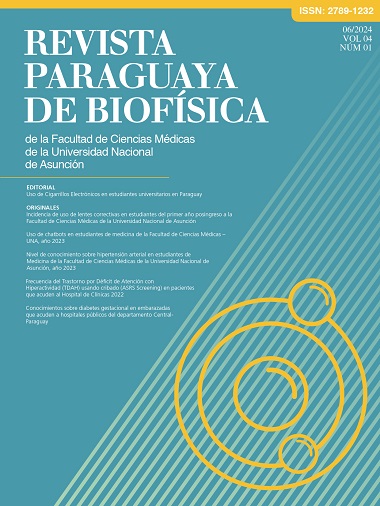Incidencia de uso de lentes correctivas en estudiantes del primer año posingreso a la Facultad de Ciencias Médicas de la Universidad Nacional de Asunción
Palabras clave:
lentes correctivas, miopía, astigmatismo, hipermetropíaResumen
Objetivo: Investigar la incidencia de utilización y variación de graduación de lentes correctivas por parte de estudiantes posingreso a la Facultad de Ciencias Médicas de la Universidad Nacional de Asunción, año 2023.
Materiales y métodos: Estudio descriptivo, observacional de corte transverso. Se llevó a cabo la investigación centrándose en estudiantes del primer año de la Facultad de Ciencias Médicas. Se recabaron datos de un total de 110 universitarios acerca de la incidencia de lentes correctivas, mediante la distribución del enlace, por Whatsapp, del cuestionario hecho en Google Forms.
Resultados: Del total de la población encuestada (n= 110), el 50,9 % refirió un tiempo de estudio de 5-6 horas por día, un 84,5 % afirmó tener familiares cercanos con afecciones oculares y alrededor del 67,3 % afirmó la utilización de lentes correctivas. El uso de lentes fue debido a afecciones oculares, entre las cuales predominó la miopía en un 79,2 %, la mayoría ya la padecía antes de ingresar a la facultad (en un 76 %), sin embargo, debieron aumentar la graduación durante el proceso (67,1 % del total).
Conclusiones: Se pudo determinar entre las afecciones oculares más frecuentes en primer lugar a la miopía, seguida del astigmatismo y la hipermetropía. Dichas patologías influyeron en la prevalencia del uso de lentes correctivas en un gran número de casos.
El proceso de preparación para el ingreso a la carrera de medicina provocó cambios en la graduación de lentes, esto debido a las horas dedicadas a la misma, resultando en un promedio de 5-6 horas de estudio diario.
Gran parte de los encuestados ya utilizaba lentes correctivas antes del ingreso a la facultad, esto puede deberse a antecedentes familiares que ya presentaban un historial clínico de dichas patologías.
Referencias
(1) Coronel-Ocampos J, Gómez J, Gómez A, Quiroga-Castañeda PP, Valladares-Garrido MJ. Computer visual syndrome in medical students from a private university in Paraguay: A survey study. Front Public Health [Internet]. 2022;10. Disponible en: http://dx.doi.org/10.3389/fpubh.2022.935405
(2) Quiñónez Rivas MA, Céspedes Cabaña MF, Stanley I. AFECCIONES OCULARES MÁS FRECUENTES EN ESTUDIANTES DE LA CARRERA DE MEDICINA Y CIRUGÍA DE LA UNA FILIAL SANTA ROSA DEL AGUARAY. AÑO 2019. Discov med [Internet]. 11 de enero de 2023 [citado 28 de junio de 2024];3(2). Disponible en: https://revistascientificas.una.py/index.php/DM/article/view/3141
(3) Zhang W, Hou X, Li C, Wang S, Liu N, Zhang Y, et al. Influencing factors associated with high myopia in Chinese college students. Front Med (Lausanne) [Internet]. 2023;10. Disponible en: http://dx.doi.org/10.3389/fmed.2023.1146291
(4) Wu P-C, Tsai C-L, Wu H-L, Yang Y-H, Kuo H-K. Outdoor activity during class recess reduces myopia onset and progression in school children. Ophthalmology [Internet]. 2013;120(5):1080–5. Disponible en: http://dx.doi.org/10.1016/j.ophtha.2012.11.009
(5) Wang J, Cheng QE, Fu X, Zhang R, Meng J, Gu F, et al. Astigmatism in school students of eastern China: prevalence, type, severity and associated risk factors. BMC Ophthalmol [Internet]. 2020;20(1). Disponible en: http://dx.doi.org/10.1186/s12886-020-01425-w
(6) Cavazos-Salias CG, Montemayor-Saldaña N, Salum-Rodríguez L, Villarreal-Del Moral JE, Garza-Leon M. Prevalencia de miopía y factores de riesgo asociados en estudiantes de medicina en Monterrey. Rev Mex Oftalmol [Internet]. 2019;93(5S):246–53. Disponible en: http://dx.doi.org/10.24875/rmo.m19000084
(7) Lapido Polanco SI, Baldoquín Rodríguez W, López González M. La miopía degenerativa desde una perspectiva social. Rev Cuba Oftalmol [Internet]. 2014 [citado el 20 de noviembre de 2023];27(3):455–70. Disponible en: http://scielo.sld.cu/scielo.php?pid=S0864-21762014000300012&script=sci_arttext&tlng=pt
(8) Jiang X, Tarczy-Hornoch K, Stram D, Katz J, Friedman DS, Tielsch JM, et al. Prevalence, characteristics, and risk factors of moderate or high hyperopia among multiethnic children 6 to 72 months of age. Ophthalmology [Internet]. 2019;126(7):989–99. Disponible en: http://dx.doi.org/10.1016/j.ophtha.2019.02.021
(9) De Rosa A. Study on the prevalence of myopia and its associated factors in China: a systemic review [Internet]. European Review. 2023 [citado el 20 de noviembre de 2023]. Disponible en: https://www.europeanreview.org/article/33559
(10) Wang Q, Bi H-Y, Wang C-F. Familial aggregation and heritability of myopia: A local population survey in Shanxi, China. J Trop Med [Internet]. 2021;2021:1–7. Disponible en: http://dx.doi.org/10.1155/2021/4847112
(11) K Custodio Sánchez. Trascendencia del síndrome visual informático debido a la exposición prolongada a aparatos electrónicos. Rev Facultad de Medicina Humana [Internet]. 2021 [citado el 20 de noviembre de 2023]. Disponible en: http://www.scielo.org.pe/scielo.php?script=sci_arttext&pid=S2308-05312021000200463
(12) Christian G Cavazos,Natalia Montemayor, Lucy Salum, Juan E Villareal, Manuel Garza,et al.Prevalencia de Miopía y factores de riesgo asociados en estudiantes de Medicina en Monterrey. Rev Mexicana de Oftalmología [Internet]. 2019 [citado el 2 de noviembre de 2023]. Disponible en:https://www.scielo.org.mx/scielo.php?script=sci_arttext&pid=S2604-12272019000500246
(13) Arellano BG, Chávez SA, Arellano AS, Chaves C: Estudio de la agudeza visual y problemas refractivos en estudiantes de medicina de la escuela su-perior politécnica de Chimborazo 2013. Scientifica[Internet] 2014[citado el 20 de noviembre de 2023].Disponible en: http://www.revistasbolivianas.org.bo/scielo.php?pid=s1813-00542014000100005&s-cript=sci_arttext&tlng=pt
Descargas
Publicado
Número
Sección
Licencia
Derechos de autor 2024 Fiorella Luján Huerta Saldívar, Alejandra Insfrán Martínez, Alan Leandro Irrazabal Peralta, Liz Araceli Jiménez Galeano, Lucas Esteban Jiménez Rojas, Evelyn Diana Carolina Kagerl Arce, Kevin Kim Lee, Romina Chae Lee Kim Lee, Larisa Judith Ledesma Fretez, Angel Sebastián León Alcaraz, María Valentina León Pereira, Erika Nahara Lindstrom Miranda, Anahí Vera San Miguel, Idalina de Jesús Stanley De Valenzuela

Esta obra está bajo una licencia internacional Creative Commons Atribución 4.0.





